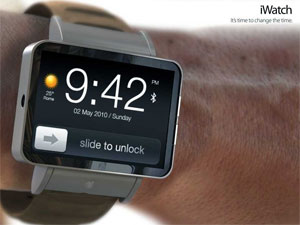

Watchmaking post
Stop, watch and learn!
Par Joël A. Grandjean /TàG Press +41
Gadgets, not watches
When even Apple jumped on the wristwatch bandwagon, followed hot-foot by Samsung and Sony, and a smattering of time-telling bracelets, you could no longer call it watchmaking. Telling the time is not enough if a device wants to call itself a watch.
 Even if we glance at it from time to time, if only to check that our mechanical watches are keeping perfect time, a smartphone is still a telephone. That it has a whole host of extra functions, that it serves to provide us with a permanent Internet connection, changes nothing. It is a terminal whose primary aim is, in any case, not to tell the time. For that function is delivered as an added bonus, almost in off-hand fashion, as meaninglessly as that of the calculator.
Even if we glance at it from time to time, if only to check that our mechanical watches are keeping perfect time, a smartphone is still a telephone. That it has a whole host of extra functions, that it serves to provide us with a permanent Internet connection, changes nothing. It is a terminal whose primary aim is, in any case, not to tell the time. For that function is delivered as an added bonus, almost in off-hand fashion, as meaninglessly as that of the calculator.
Mechanical imagery
Manufacturing mechanical watches in the third millennium is just as incongruous as manufacturing steam locomotives in the era of the high-speed train. Although highly evolved and up-to-date as regards production processes and materials, these locomotives are nonetheless equipped with a real wooden furnace and a large drive wheel, spitting out their delicious smoke and announcing their imminent arrival with their traditional fanfare. Where extreme precision is concerned, we are in an era where the atomic clock is capable of measuring time to the billionth of a second. And we can receive that time, give or take a hundredth of a second or so, and thanks to the GMT-UTC network, on our smartphones, our computers or on the radio-controlled clocks found on station platforms.
Mechanical watchmaking, however, with its intricate mechanisms and hands, is inspirational. The watchmaking brand, Slyde, pays it tribute, even in its latest models where the touch screen displays a picture of a tourbillon. Other brands dare, on a regular basis, to combine the fields of ultra-precise electronic timepieces and micromechanical time-telling. Ventura, for example, is a pioneer in radio-controlled timekeepers for the wrist that still makes use of the rotor. A collection of chronographs exists from manufacturers such as Breitling or TAG Heuer, which combine the two technologies. Mechanically-driven time-telling tools requiring hands can be found side-by-side with electronic functions driving a digital display. Where mobile phones are concerned, the Ulysse Nardin smartphone uses a hybrid system, where the energy is recharged by an oscillating weight.
 Now that’s watchmaking!
Now that’s watchmaking!
In the world of timekeeping, where the gap between electronic and mechanical is rarely bridged, quite another source of inspiration is getting the master watchmaker’s creative juices flowing. The digital watch, often powered electronically (even though the original timekeeper with jumping hours could also lay claim to this description) is a great source of inspiration. The first person to fall under its spell was Fawaz Gruosi of the Grisogono brand responsible for the stylish-looking Meccanico dg resplendent with green filament, its display powered entirely by a complicated calibre. Much time was needed to make it reliable and commensurate with its high purchase price. More recently, the arrival of the HM5 On The Road Again from Maximilian Büsser is reminiscent of a museum piece with lateral display carrying the Girard Perregaux signature. A daring design launched during the short reign of the red filament quartz rapidly to be dethroned by the LCD concept. The last Horological Machine encased watchmaking genius in its purest state in the form of an ultra-mechanical calibre. In the same vein, came a design piece co-produced by Manuel Emch, Eric Giroud and Jean-Marc Widerrecht entitled Spacecraft.
The smartwatch, an opportunistic gadget?Examples of mechanical watchmaking that derive their inspiration from the electronic digital watch are genuine exercises in horological style. They have nothing in common with the multitude of timekeeping gadgetry championed by Apple. They are mere playthings that have no place on the wrist. They oppose all the values that contemporary watchmaking stands for today. They will provide no employment for watchmakers fresh out of college. They will never fuel research and development into complications or materials. They will never exude that magic that fills the enthusiast with awe whenever he chances to see the beating of the mechanical heart inside his timepiece. Let us hope that these blots on the watchmaking landscape are not going to deter the aficionados and collectors from their true conquests! Please let them not poach the multi-functional watch market through some kind of perverse effect of fashion. This message comes from a big fan of Steve Jobs, and one of the first followers of the Macintosh: buy yourself the T-Touch that is undoubtedly missing from your collection rather than fall under the spell of these evil opportunistic gadgets.
©
toute reproduction strictement interdite
Tweet
On the forum (in french)
Version française
English section